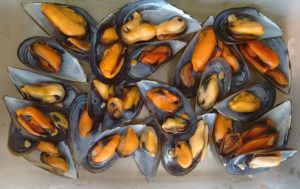Mussels (Mytilus edulis) are a common ingredient in Spanish cuisine. They are cooked in many different ways, either just boiled with a squeeze of lemon juice over them, or even better, added to stews or paella.
After spending a couple of weeks in Galicia (north-west corner of Spain) and trying a few of these plates made by locals, I found that my absolute favourite is as easy to make as it is delicious.
Foraging for seafood in Galicia is, however, forbidden by law, as there are professional “Marisqueiros” (seafood collectors), who need to have a license to catch and sell the fruits of their seas. Thankfully, the situation in the UK is different and makes it possible for seafood-lovers to make a trip to their nearest beach and try to find these little black-and-orange animals. The amount and size of mussels you find around the coasts of the British Isles are much smaller than in Galicia, so make sure you don’t take more than you need and let the small ones continue to live on the rocks. It’s also really important to try and get advice from the locals before you go out foraging for mussels, as they may be kind enough to warn you of issues with water quality, local sewage outflow pipes (which you’d want to avoid for obvious reasons), and anything else you may need to be aware of, including any kind of local bylaws preventing the collecting of the mussels. Checking your local tides is going to be really important too – a nice low tide is going to give you a good opportunity to go out and reach the mussel beds, allowing you to collect larger specimens whilst also lowering your risk of getting caught out when the tide is high. It goes without saying that you have to take extreme care when you go out foraging for mussels or any other more wild coastal ingredients, and make sure you tell someone about your intentions as well as telling them what time to expect you back home, armed hopefully with a good haul of delicious shellfish.
The Best Way to Cook Mussels
So here (in our opinion) is the best way to cook mussels, especially for those that are new to the delights of mussels or have perhaps had bad experiences with them previously. It’s a Galician recipe that seafood sceptics should love, and it works with both shop-bought fresh mussels as well as wild, foraged-for mussels. Enjoy!
Ingredients:
- Around 1 kg Mussels

- 1 Onion
- 2 Cloves of garlic
- 400 gr. pasatta or self-made tomato sauce.
- 100 gr. Jamon Serrano (Spanish ham)
- Water
- 2 tbsp. olive oil
- One bay leaf (optional)
- A pinch of salt
- A pinch of sugar
Preparation:
- Wash the mussels thoroughly under cold water, making sure there is no sand or dirt over them.
- Put the mussels in a saucepan and pour water over them – not much! They just need to be covered by it, not completely submerged. Add the bay leaf and a pinch of salt and bring it all to boil.
- While the mussels cook, you can start preparing the sauce. Chop the onion and garlic as small as you can and cut the jamon into short, thin stripes.
- Use a frying pan to fry the onion and garlic in the olive oil and when these are soft, add the ham stripes. Fry it all together for a couple of minutes and then add the tomato sauce or passata. Add the pinches of salt and sugar and let it cook for about 10 minutes.
- After the mussels have opened, you will see that the level of water has increased a lot. Sieve the water and keep it – you can use it for preparing a lovely risotto or fish stew! Place the mussels on a tray, leaving just one of the shells and getting rid of the other one if you want – just to save space!
- Now all you have to do is pouring the tomato and ham sauce on the mussels, one tablespoon at a time.
- The mussels are ready to eat, buen provecho!!

